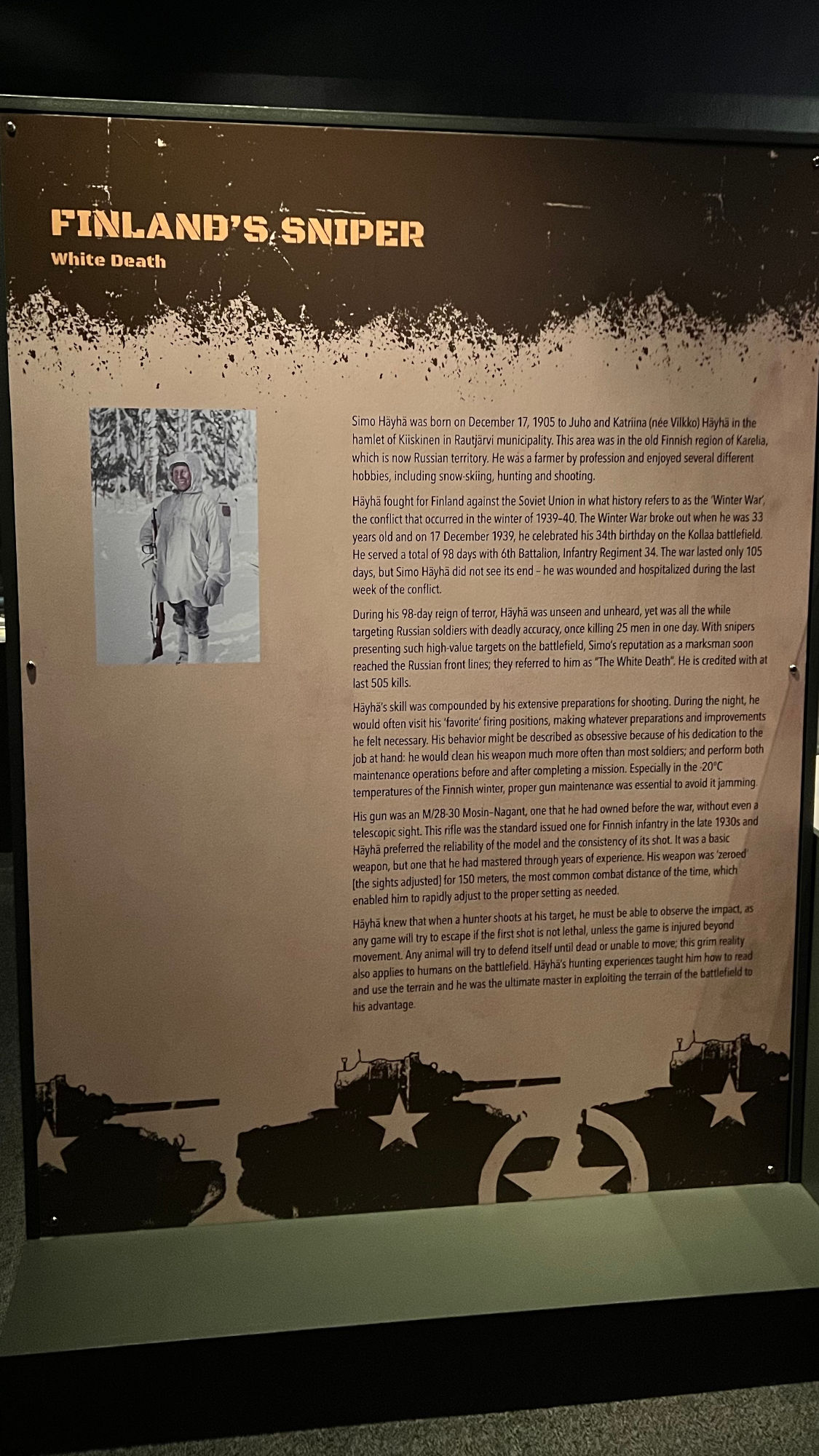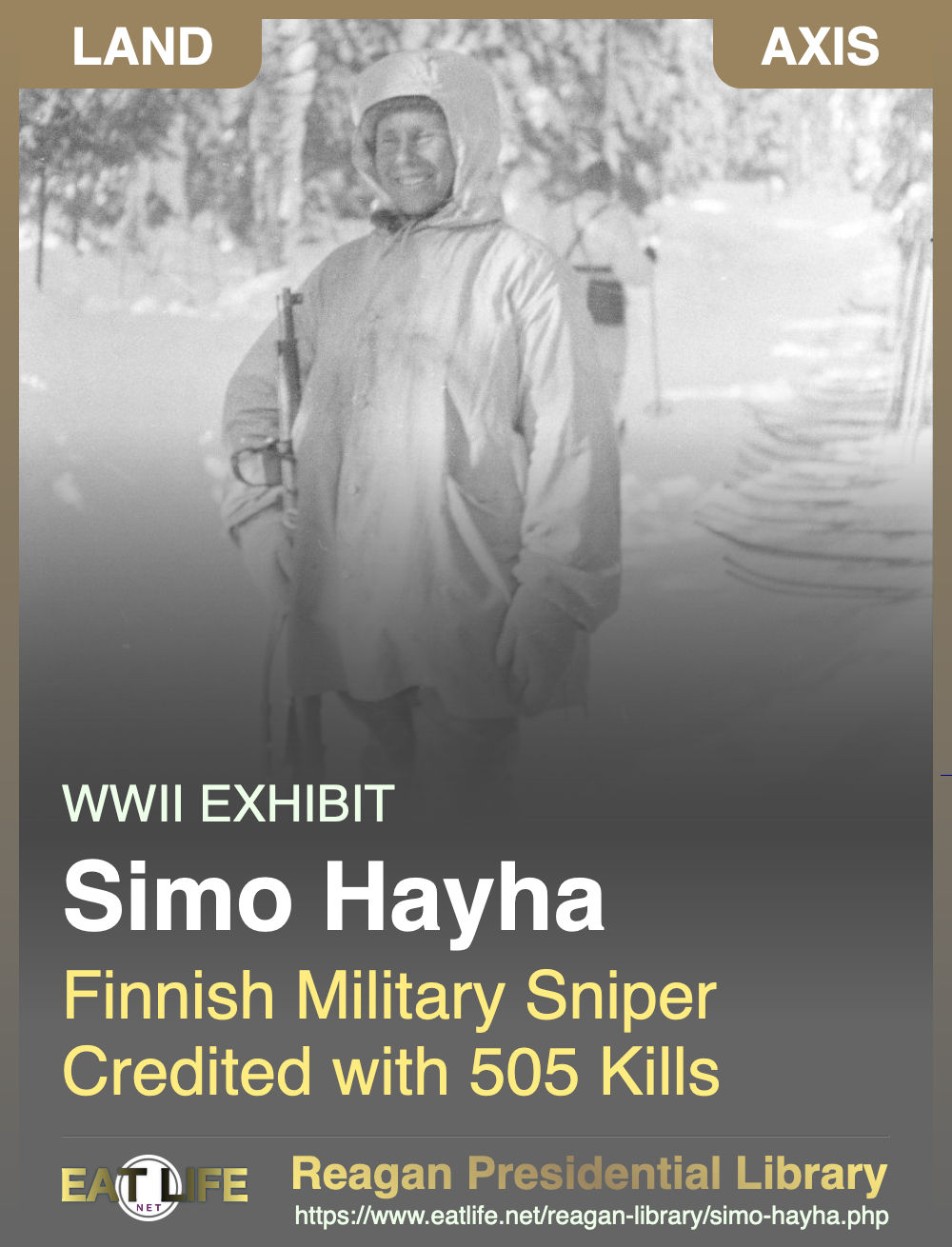Finnish military sniper during World War II in the 1939-1940 Winter War (Finland against the Soviet Union). Hayha was unseen and unheard, yet was all the while targeting Russian soldiers with deadly accuracy, once killing 25 men in one day. Simo's reputation as a marksman soon reached the Russian front lines; they referred to him as "The White Death". He is credited with at least 505 kills.
At the end of the Winter War he was severely wounded and thought dead after an explosive bullet fired by a Red Army soldier hit him in the jaw.

White Death
Simo Hayha was born on December 17, 1905 to Juho and Katrina (ree Vilkko) Hayha in the hamlet of Kiskinen in Rautarvi municipality. This area was in the old Finnish region of Karelia, which is now Russian territory. He was a farmer by profession and enjoyed several different hobbies, including snow-skiing, hunting, and shooting.
Hayha fought for Finland against the Soviet Union in what history refers to as the Winter War, the conflict that occurred in the winter of 1939-40. The Winter War broke out when he was 33 years old and on 17 December 1939, he celebrated his 34th birthday on the Kollaa battlefield. He served a total of 98 days with 6th Battalion, Infantry Regiment 34. The war lasted only 105 days, but Simo Hayha did not see its end - he was wounded and hospitalized during the last week of the conflict.
During his 98-day reign of terror, Hayha was unseen and unheard, yet was all the while targeting Russian soldiers with deadly accuracy, once killing 25 men in one day. With snipers presenting such high-value targets on the battlefield, Simo's reputation as a marksman soon reached the Russian front lines; they referred to him as "The White Death". He is credited with at least 505 kills.
Hayha's skill was compounded by his extensive preparations for shooting. During the night, he would often visit his 'favorite' firing positions, making whatever preparations and improvements he felt necessary. His behavior might be described as obsessive because of his dedication to the job at hand: he would clean his weapon much more often than most soldiers; and perform both maintenance operations before and after completing a mission. Especially in the -20C temperatures of the Finnish winter, proper gun maintenance was essential to avoid it jamming.
 His gun was an M/28-30 Mosin-Nagant, one that he had owned before the war, without even a telescopic sight.
This rifle was the standard issued one for Finnish infantry in the late 1930s and Hayha preferred the reliability of the model and the consistency of its shot.
It was a basic weapon, but one that he had mastered through years of experience.
His weapon was 'zeroed' (the sights adjusted) for 150 meters, the most common combat distance of the time, which enabled him to rapidly adjust to the proper setting as needed.
His gun was an M/28-30 Mosin-Nagant, one that he had owned before the war, without even a telescopic sight.
This rifle was the standard issued one for Finnish infantry in the late 1930s and Hayha preferred the reliability of the model and the consistency of its shot.
It was a basic weapon, but one that he had mastered through years of experience.
His weapon was 'zeroed' (the sights adjusted) for 150 meters, the most common combat distance of the time, which enabled him to rapidly adjust to the proper setting as needed.
Hayha knew that when a hunter shoots at his target, he must be able to observe the impact, as any game will try to escape if the first shot is not lethal, unless the game is injured beyond movement. Any animal will try to defend itsell until dead or unable to move, this grim reality also applies to humans on the battlefield. Hayha's hunting experiences taught him how to read and use the terrain and he was the ultimate master in exploiting the terrain of the battlefield to his advantage.
WIKIPEDIAThe Mosin–Nagant is a five-shot, bolt-action, internal magazine–fed military rifle.
Known officially as the 3-line rifle M1891 and informally in Russia and the former Soviet Union as Mosin's rifle. It is primarily found chambered for its original 7.62×54mmR cartridge.Developed from 1882 to 1891, it was used by the armed forces of the Russian Empire, the Soviet Union and various other states. It is one of the most mass-produced military bolt-action rifles in history, with over 37 million units produced since 1891. In spite of its age, it has been used in various conflicts around the world up to the present day.
At the beginning of the world war II, the Mosin-Nagant 91/30 was the standard issue weapon of Soviet troops. Millions were produced in World War II for use by the largest mobilized army in history.
The Mosin–Nagant Model 1891/30 was modified and adapted as a sniper rifle from 1932 onwards, first with mounts and scopes from Germany then with domestic designs (PE, PEM); from 1942 it was issued with 3.5-power PU fixed focus scopes. It served quite prominently in the brutal urban battles on the Eastern Front, such as the Battle of Stalingrad, which made heroes of such snipers as Vasily Zaitsev, Lyudmila Pavlichenko, Ivan Sidorenko, and Roza Shanina.
Finland also employed the Mosin-Nagant as a sniper rifle, with similar success with their own designs and captured Soviet rifles. For example, Simo Hayha is credited with having killed 505 Soviet soldiers, many of whom fell victim to his Finnish M/28-30 Mosin–Nagant rifle. Hayha did not use a scope on his Mosin. In interviews Hayha gave before his death, he said that the scope and mount designed by the Soviets required the shooter to expose himself too much and raise his head too high, increasing the chances of being spotted by the enemy. In addition, scopes tended to reflect sunlight when moved side to side, which gave away a sniper's position.
Most Finnish Rifles were assembled by SAKO, Tikkakoski Oy, or VKT (Valtion Kivaaritehdas, State Rifle Factory, after the wars part of Valtion Metallitehtaat (Valmet), State Metalworks). The Finnish cartridge 7.62×53mmR is a slightly modified variation of the Russian 7.62×54mmR, and is considered interchangeable with 54R. However, the older version of the Finnish military cartridge was loaded with the S-type bullet that had nominal diameter of .308. In 1936 the Finnish Army fielded a new standard service cartridge intended for both machine guns and rifles. This new cartridge was loaded with a new bullet designed in 1934–the D-166, which had a nominal diameter of .310. The new service rifle m/39 was designed from the start around the D-166 thus it had nominal barrel diameter of .310.
Handloaded cartridges for Finnish rifles should however use a 0.308 inches (7.8 mm) bullet for use with other Finnish Mosin–Nagant variants instead of the 0.310 inches (7.9 mm) one which gives best results in M39, Soviet and most of other Mosin–Nagant rifles.
FinlandM/28
A variant designed by the White Guard. The M/28 differs from the Army's M/27 primarily in the barrel band design, which is a single piece compared to the M/27's hinged band, and an improved trigger design. Barrels for the M/28 were initially purchased from SIG, and later from Tikkakoski and SAKO.
WIKIPEDIASimo Hayha
The White Death
Was a Finnish military sniper in World War II during the 1939-1940 Winter War against the Soviet Union. He used a Finnish-produced M/28-30 (a variant of the Mosin–Nagant rifle) and a Suomi KP/-31 submachine gun. He is believed to have killed over 500 enemy soldiers during the Winter War, the highest number of sniper kills in any major war. Because of this, he is often regarded as the deadliest sniper of all time.Hayha served as a sniper in the Finnish Army during the 1939-40 Winter War between Finland and the Soviet Union, under Lieutenant Aarne Juutilainen in the 6th Company of Infantry Regiment 34 (Jalkavakirykmentti 34, or JR 34) during the Battle of Kollaa in temperatures between -40 and -4 F. He was dressed completely in white camouflage; Soviet troops were not issued camouflage uniforms for most of the war, making them easily visible to snipers in winter conditions. Joseph Stalin had purged military experts in the late 1930s as part of the Great Purge, and the Red Army was consequently highly disorganized.
Finnish sources state that Hayha was nicknamed "The White Death" by the Red Army. The name "White Death" has been suggested to originate entirely in Finnish propaganda, rather than having been given to Hayha by the Russians; according to information from prisoners, to the Russians "White Death" referred to a severe frost in the deep forest. Hayha having the nickname "White Death" first appeared in the Finnish Winter War literature of the late 1980s. During the war, the "White Death" was one of the leading themes of Finnish propaganda. Finnish newspapers frequently featured the invisible Finnish soldier, thus creating a hero of mythical proportions. To add to the myth, he was also nicknamed "The Magic Shooter" among Finns.
All of Hayha's kills were accomplished in less than 100 days, an average of five per day at a time of year with very few daylight hours. His kill count as a sniper was based on his own reporting, with the confirmation of his comrades, and only those who were verified to be dead were counted. No count was taken when several snipers shot at the same target. Enemy soldiers killed with a submachine gun with Hayha as a group leader were not counted.
Hayha's division commander Antero Svensson credited him with 219 confirmed kills with a rifle and an equal number of kills by submachine gun, when he awarded Hayha with an honorary rifle on 17 February 1940. On 21 December 1939, Hayha achieved his highest daily count of 25 kills. In his diary, military chaplain Antti Rantamaa reported 259 confirmed kills made by rifle and an equal number of kills by submachine gun from the beginning of the war until 7 March 1940, one day after Hayha was severely wounded. Later in his book, Rantamaa credited Hayha with a total of 542 kills.
Injury
On 6 March 1940, Hayha was severely wounded after an explosive bullet fired by a Red Army soldier hit his lower left jaw. After the battle, as he appeared to be dead, he was placed on a pile of dead bodies.Rumours of Hayha's death spread around in Finland and the Soviet Union. He regained consciousness a week later on 13 March, the day that The Winter War peace was declared. He read about his own death in a newspaper, and sent a letter to the paper to correct the misunderstanding.







